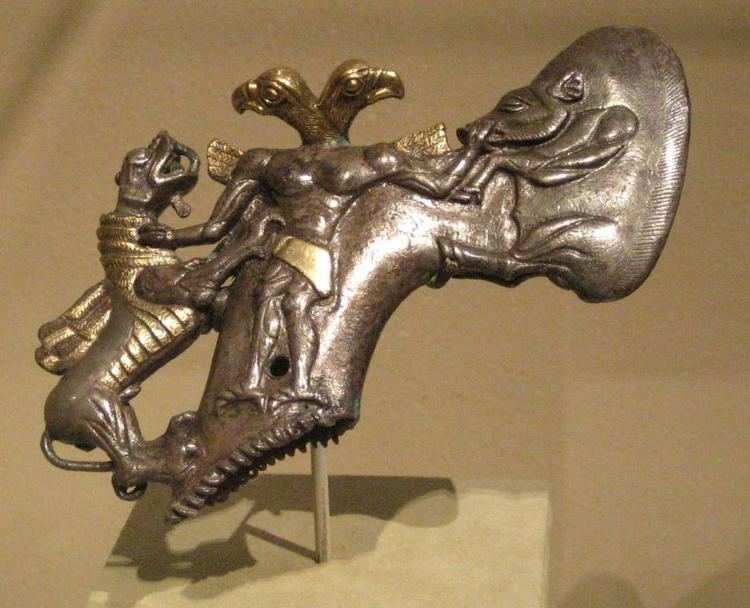 | ||
Persian-Sassanide art patterns have similarities with the art of the Bulgars, Khazars, and Saka-Scythians, and have recurred in Asia. They predominantly feature motifs of fighting animals. Gold was frequently used as a base for their art creations.
Contents
Patterns
The characteristic patterns of Persian-Sassanide art exhibit similarities to the art of the Bulgars, Khazars, and Saka-Scythian, and have recurred at different locations in the Central Asia region. A "griffin fighting an elk" motif from the Treasure of Nagyszentmiklós, found in 1799 in what is today Romania, bears similarities with another griffin & elk motif discovered in the tombs of Hsiung-nu (early Huns, also Xiongnu) during Colonel Pyotr Kuzmich Kozlov expedition (1907–09) near Urga (Outer Mongolia).
A gold symbolization of "animals-in-fight" has been also found in the vicinity of the city of Turpan, the principal crossroad of the northern Silk Road. Golden "animals-in-fight" have also been identified as 3rd – 2nd century B.C. Mongolia (or southern Siberia), being characteristic of Hsiung-nu or Xiongnu.
The Art of the Nomads
The early history of the Nomads is not well recorded, which changed after their contact with cultures possessing written history. Nomadic people of the vast steppes of Asia were a major force in history. Their power was not in the empires they built, but rather the turmoil they created among ancient civilizations such as China or Persia, impacting their historical development substantially. It is believed that the nomads ranged widely, forever moving on for sake of richer grazing for their horses and sheep. Migrations were often seasonal. Their skill at extracting gold was unprecedented. In summer, during the tribe's seasonal migration, a fleece would be weighted on a riverbed to collect particles of alluvial gold. Upon the tribes' return, the fleece would be sheared, burned, and a gold ingot the size of a horse's hoof would result. The tay tayak (the horse's hoof) was a unit of gold for a long period, which was used as a measure of an amount of golden metal rather than money, since gold was not fabricated as currency. Using gold was a spiritual practice, as emblems of priestly office, prizes for physical prowess in ritual sport, or as adornment of the sacral ceremony of marriage.
Art Recursion
Barthes discusses the art patterns as narratives of cultural coexistence (for details see: Introduction to structural analysis of narratives). However, Spivey summarizes that cultural coexistence is not the single reason to explain the phenomenon of art being recursive. Chomsky at al. argued that the core property of human communication (in a "narrow" sense, including language) is recursion. According to Chomsky at al. recursion is attributed to limited syntax in the conception, with a finite set of elements to yield a potentially infinite array of discrete expressions. Thomas explains the art recursion (in a "broad" sense) with implosion of archetypal structures existing beyond the faculty of human communication. Studying Persian-Sassanide art patterns and possibly their early Nomadic conceptions is uncovering their symbols (symbolism) and creative imagination.
